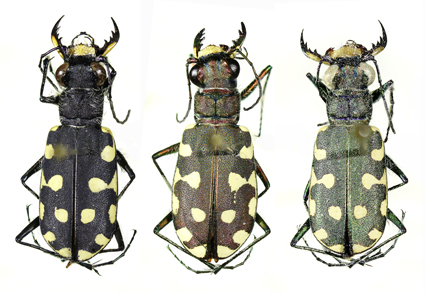Abstract
For the past couple of centuries, much of tiger beetle taxonomic work has been focused on explaining intraspecific variation. In the Northern Hemisphere, over a thousand subspecies have been described and many have since been relegated to synonymy. Generally, the phenotypic-based subspecies circumscription has been purely descriptive. More quantitative and integrative analyses of the color and pattern variation in tiger beetles would be valuable. The geographically wide-ranging species, Calomera littoralis (Fabricius, 1987) contains 11 currently recognized subspecies, including two described from Mongolia that have been of questionable status due to the paucity of material available when they were described. Here, we assess the distribution of phenotypic variation within C. l. peipingensis (Mandl, 1934) and C. l. mongolensis (Mandl, 1981) to determine whether it best fits a pattern of two subspecies with a contact zone or a gradual cline, based on 494 specimens from 34 populations. Non-metric multidimensional scaling analyses and modeling of the fit between longitude and black dorsal phenotypes both indicate that the variation is best explained by a gradual cline of phenotype along an east-west gradient, not the presence of separate subspecies. As a result, we synonymize C. littoralis mongolensis, syn, nov. with C. littoralis peipingensis.
References
- Alonso, M., Nergui, S., Garcia-Murcia, A. & Pla-Rabes, S. (2019) Contribution to the lake algal flora and microcrustacean fauna of the Great Lakes Depression, Mongolia. Mongolian Journal of Biological Sciences, 17, 41–56. https://doi.org/10.22353/mjbs.2019.17.06
- Bray, J.R. & Curtis, J.T. (1957) An ordination of the upland forest communities of southern Wisconsin. Ecological Monographs, 27, 325–349.
- Burbrink, F.T., Crother, B.I., Murray, C.M., Smith, B.T., Ruane, S., Myers, E.A. & Pyron, R.A. (2022) Empirical and philosophical problems with the subspecies rank. Ecology & Evolution, 12, e9069. https://doi.org/10.1002/ece3.9069
- Dorjsuren, B., Zemtsov V.A., Batsaikhan, N., Demberel, O., Yan, D., Hongfei, Z., Yadamjav, O., Chonokhuu, S., Enkhbold, A., Ganzorig, B., Bavuu, E., Namsrai, O., Xiang, L., Yingjie, Y. & Siyu, W. (2024) Trend analysis of hydro-climatic variables in the Great Lakes Depression region of Mongolia. Journal of Water and Climate Change, 15 (3), 940–957. https://doi.org/10.2166/wcc.2024.379
- Duran, D.P. (2010) Speciation and diversification in the North American tiger beetles of the Cicindela sylvatica group: Morphological variation and an ecophylogeographic approach. Ph.D. Dissertation, Vanderbilt University, Nashville, Tennessee, 267 pp.
- Duran, D.P., Laroche, R.A., Gough, H.M., Gwiazdowski, R.A., Knisley, C.B., Herrmann, D.P., Roman, S.J. & Egan, S.P. (2020) Geographic life history differences predict genomic divergence better than mitochondrial barcodes or phenotypes. Genes, 11, 265. https://doi.org/10.3390/genes11030265
- Duran, D.P., Laroche, R.A., Roman, S.J., Godwin, W., Herrmann, D.P., Bull, E. & Egan, S.P. (2024) Species delimitation, discovery and conservation in a tiger beetle species complex despite discordant genetic data. Scientific Reports, 14, 6617. https://doi.org/10.1038/s41598-024-56875-9
- Jaskuła, R., Rewicz, T., Płóciennik, M. & Grabowski, M. (2016) Pleistocene phylogeography and cryptic diversity of a tiger beetle, Calomera littoralis, in North-Eastern Mediterranean and Pontic regions inferred from mitochondrial COI gene sequences. PeerJ, 4, e2128. https://doi.org/10.7717/peerj.2128
- Laroche, R.A., Duran, D.P., Lee, C.T.A., Godwin, W., Roman, S.J., Herrmann, D.P. & Egan, S.P. (2023) A genomic test of subspecies in the Eunota togata species group (Coleoptera: Cicindelidae): Morphology masks evolutionary relationships and taxonomy. Molecular Phylogenetics & Evolution, 189, 107937. https://doi.org/10.1016/j.ympev.2023.107937
- Mandl, K. (1981) Revision der unter Cicindela lunulata F. im Weltkatalog der Cicindelinae zusammengefaßten Formen (Col., Cicindelidae). Entomologische Arbeiten aus dem Museum Gg. Frey, 29, 117–76.
- Morgan, M., Knisley, C.B. & Vogler, A.P. (2000) New taxonomic status of the endangered tiger beetle, Cicindela limbata albissima (Coleoptera: Cicindelidae): evidence from mtDNA. Annals of the Entomological Society of America, 93 (5), 1108–1115. https://doi.org/10.1603/0013-8746(2000)093[1108:NTSOTE]2.0.CO;2
- New, T.R. (2007) Beetles and conservation. Journal of Insect Conservation, 11, 1–4. https://doi.org/10.1007/s10841-006-9022-0
- R (2024) R: A Language and Environment for Statistical Computing R Foundation for Statistical Computing. Available from: https://www.r-project.org/ (accessed 1 May 2024)
- Schultz, T.D. (1983) The ultrastructure, physiology, and ecology of epicuticular interference reflectors in tiger beetles (Cicindela). Ph.D. Dissertation. The University of Texas, Austin, Texas, 214 pp.
- Shelford, V.E. (1917) Color and color pattern mechanism of tiger beetles. Illinois Biological Monographs, 3, 395–532. https://doi.org/10.5962/bhl.title.16983
- Slatkin, M. (1993) Isolation by distance in equilibrium and non-equilibrium populations. Evolution, 47 (1), 264–279. https://doi.org/10.1111/j.1558-5646.1993.tb01215.x
- Wiesner, J. (2020) Checklist of the Tiger Beetles of the World. 2nd Edition. Edition Winterwork, Borsdorf, 540 pp.
- Wilson, E.O. & Brown, W.L. (1953) The subspecies concept and Its taxonomic application. Systematic Zoology, 2, 97–111. https://doi.org/10.2307/2411818
- Yembuu, B. (Ed.) (2021) The Physical Geography of Mongolia. Springer, Cham, 218 pp. https://doi.org/10.1007/978-3-030-61434-8


